Abstract
In the present study, questionnaires and field measurements were carried out to investigate the thermal sensation, thermal preference, and adaptive behavior of 216 elderly people living in rural mutual aid homes in central Inner Mongolia from 15 December 2020 to 31 December 2020. The main objective of this article was to understand the thermal comfort of the elderly at different ages and provide a reference for the design and construction of mutual aid homes from the perspective of adaptive thermal comfort. The obtained results showed that the average clothing thermal resistance of the elderly is 1.36 clo, and the thermal neutral temperature is 20.52 °C. Moreover, the 80% acceptable temperature range of the elderly is 15.48–25.56 °C, and the thermal expectation temperature is 21.09 °C. Then, an adaptive thermal comfort model was established for the elderly in rural mutual aid hospitals in the region. It was found that the thermal resistance, thermal neutral temperature, and thermal sensitivity of the clothing of the elderly of different ages are significantly different. The difference is especially more pronounced for the elderly over 80 years. Therefore, the differences in the thermal comfort needs of the elderly of different ages should be considered in the construction of rural mutual aid homes. This article is expected to provide a reference for the design of rural mutual aid homes and the update of heating systems.
1. Introduction
China has faced the serious problem of population aging since it became an aging society in the 2000s [1,2]. This problem is especially more pronounced in rural communities, where the labor shortage has caused more serious pension problems than in cities. According to China’s seventh national census in 2020, the proportion of the resident population older than 60 and 65 in rural areas was 7.99% and 6.61% higher than that in urban areas, respectively [3]. Moreover, the loss of young people in rural areas has weakened the traditional family model of old-age care. As a result, the issues related to the elderly, including empty-nest elderly, lonely elderly, and childless elderly in rural areas, have become a concern for the whole society.
A new model of rural social pensions, called rural mutual aid homes, was proposed in 2008 [4]. The emergence of this model effectively relieved the existing pressure of old-age care in rural areas of China. In some developed countries, such as Japan, Germany, and the United States, unique models of mutual care for the elderly have been developed in conjunction with the current situation in each country [5,6,7]. According to research, the housing conditions, energy efficiency, thermal comfort, and home adaptations in place to facilitate aging are particularly important housing characteristics to older people [8]. Studies showed that the current rural mutual aid homes in China are still in the primary development stage, and the living places of the elderly do not reflect “mutual aid” well and are not necessarily “suitable for the elderly”. More specifically, the demand of the elderly for indoor air conditioning and thermal comfort is not usually fully considered. Consequently, the indoor comfort of these places is lower than that of other elderly care facilities.
Against the backdrop of the growing problems of global aging, healthy aging has become one of the key themes of the World Health Organization (WHO) and is included in the future program of this organization [9]. According to statistics, ordinary people spend about 90% of their time indoors, and the elderly who need care spend even 100% of their time indoors [10,11]. With age, physiological functions and self-resistance gradually reduce. Studies show that there are significant differences between the elderly and young people in thermal sensation, comfort, acceptability, and preferred temperature [12]. Thermal sensation is the human body’s subjective description of whether the surrounding environment is “cold” or “hot”. Thermal preference refers to the degree to which a person has a preference for hot or cold in the environment. Adaptive thermal comfort behavior refers to a person’s response to cold or heat, and it is very broad, referring to all aspects of physical, psychosocial, and behavioral responses [13].
Van Hoof and Hensen concluded that “in general, older adults have reduced: muscle strength, work capacity, sweating capacity, ability to transfer heat from body core to skin, hydration levels, vascular reactivity and cardiovascular stability”. However, this does not necessarily lead to a need for higher ambient temperatures in cold conditions, as older people may wear more clothing. Therefore, it is clear that any useful discussion of thermal comfort must also consider any adaptive behaviors used by the elderly to achieve better thermal conditions in their residences [14]. However, the thermal preferences and expectations of older adults must not be neglected, as older people, having lived for longer, have a richer history and a wider range of thermal experiences [15]. Generally, older people are more vulnerable to extreme weather during summer or winter because they are relatively frail and prone to various health problems [16,17]. In order to improve the elderly living environment, it is necessary to investigate the adaptive thermal comfort, thermal preferences, and thermal expectations of the elderly.
Reviewing the literature indicates that many investigations have been carried out on the thermal comfort of the elderly. Natsume compared the winter and summer thermal sensation of two groups of people aged 71–76 and 21–30 and found that the elderly were less sensitive to the thermal environment [18]. Lee et al. classified their studied volunteers into 20-year-old, 40-year-old, and 60-year-old classes and studied the thermal sensation of each class in different seasons. It was found that the older the volunteer was, the more cold they felt and the less comfortable [19]. Tartarini et al. [20] analyzed the current situation of indoor thermal environments in retirement buildings in the Australian region and conducted a subjective questionnaire study on the thermal comfort of elderly and found that, under the same condition of indoor thermal environment, elderly people who lived in the local area for a long time were better adapted. Panraluk et al. [21] studied the thermal comfort of elderly people in public health service buildings in Thailand and conducted a comparative analysis of the thermal comfort of the elderly with regard to three aspects: gender, age, and health status. The authors put forward guidelines for multipurpose senior centers in Thailand from the perspective of thermal comfort and energy saving [22]. Accordingly, it was found that gender, age, and health status significantly affected the thermal sensation of the elderly.
Recently, many investigations have been conducted on the thermal comfort of elderly people in different regions of China. Yao Xinling studied the thermal comfort of elderly people in Shanghai nursing homes and found that the winter thermal neutral temperature of elderly people in Shanghai was 16.6 °C, while the acceptable temperature range was 18.3–22.1 °C [23]. Liu Hong found that the thermal sensory voting value of the local elderly was low, resulting in a low dissatisfaction rate. Moreover, investigating the thermal comfort of the elderly in summer nursing institutions in Chongqing showed that the upper limit of acceptable temperature was high [24]. Guangtao Fan et al. analyzed the thermal comfort of the urban and rural elderly in Beijing and concluded that the acceptable temperature range of the rural elderly was much greater than that of the urban elderly [25]. Zheng Wuxing et al. studied the thermal comfort of the elderly in Xi’an, China, in different seasons and found that the thermal sensitivity of the elderly in winter was 0.067, which is lower than that in summer and transition seasons [26].
The performed literature survey on thermal comfort indicates that there is a lack of research on the thermal comfort of the elderly in the cold regions of northern China [26,27], and no thermal comfort studies have been conducted on rural mutual aid homes and the elderly in central Inner Mongolia. Now, with the rapid development of the rural mutual aid pension model in China, the demand for mutual aid buildings for the elderly is increasing. However, the thermal comfort needs of the rural elderly have been neglected. Aiming at addressing this shortcoming, this paper innovatively studies the adaptive thermal comfort of the elderly in rural mutual aid buildings in central Inner Mongolia. The main objective of the present study is to reveal the current situation of indoor thermal environment and to analyze the adaptive thermal comfort behavior and psychology, thermal sensation, thermal expectation, and thermal satisfaction of elderly people at different ages in rural mutual aid homes in central Inner Mongolia in winter. According to the current situation of the existing mutual aid homes and the thermal comfort demand of the elderly at different ages, corresponding improvement suggestions are put forward so as to provide a reference for the improvement of the living environment of rural mutual aid homes.
2. Materials and Methods
As an emerging model of old-age care in China, the concept of the rural mutual aid old-age care model has not yet been uniformly defined academically. Since no name has been chosen for these facilities yet, they are often called “mutual aid happy homes”, “mutual aid old-age care centers”, and “happy homes”. Similarly, rural mutual help elderly care facilities are often called “mutual help happy homes”, “mutual help elderly care centers”, and “happy compounds”. In the present study, the carriers of the rural mutual help elderly care model are hereafter called “mutual aid homes”.
2.1. Geography and Climatic Condition
The central region of Inner Mongolia is located in northern China. By geographic location, the Inner Mongolia Autonomous Region is divided into three regions: the central, eastern, and western regions. Considering the large east–west span of this region, it has diverse climatic characteristics. The central Inner Mongolia region mainly includes Hohhot (110°46′−112°10′ E, 40°51′−41°8′ N), Ulanqab (110°26′–114°49′ E, 40°10′–43°28′ N), and Xilingol (115°13′–117°06′ E, 43°02′–44°52′ N) regions. According to the Köppen–Geiger Climate Classification [28], Hohhot, Ulanqab, and Xilingol belong to the BSk class. The region has long and cold winters that last about 6 months, followed by dry spells with little rain, a short transitional season, and a comfortable summer climate.
The winter meteorological data of a typical meteorological year (1 October 2002–28 April 2003) were selected to analyze the average daily outdoor temperature, maximum temperature, minimum temperature, and relative humidity in the three regions. Figure 1 shows that the range of daily average temperature in Hohhot, Ulanqab, and Xilingol regions is −23.1–15.6 °C, −22.8–15.7 °C, and −28–16.1 °C, respectively. Moreover, the daily average humidity is 55.3%, 62.7%, and 63.8%, respectively, and the instantaneous humidity varies in the range of 30–70%.

Figure 1.
Daily outdoor temperature and relative humidity from 1 October to 28 April in a typical meteorological year in (a) Hohhot; (b) Ulanqab; and (c) Xilingol.
2.2. Questionnaire Survey
In the present study, a subjective questionnaire was used to conduct on-site research on the thermal comfort of the elderly living in mutual aid homes. Considering the low literacy level of rural elderly in central Inner Mongolia and the vision and hearing impairment in some elderly people, they were not able to complete the questionnaire alone. To prevent any misunderstanding of the respondents, the questionnaires were filled out by the team members. It is worth noting that all team members were postgraduate students who had studied theories and methods related to human thermal comfort.
The questionnaire was designed by our team. In order to ensure that the elderly could easily understand the questions, professional terms appearing in the questionnaire were replaced with easy-to-understand words. The survey collected the following information:
- (1)
- basic information about the older adults, such as gender, age, and clothing;
- (2)
- perceptions of temperature, humidity, air quality, and thermal comfort levels using a seven-point scale for the TSV and five-point scale for the thermal comfort vote (TCV);
- (3)
- thermal preference vote (TPV) and thermal acceptance vote (acceptability of the thermal environment at a TSV range from −1 to 1).
The main evaluation indicators are presented in Table 1.

Table 1.
Scales used in the questionnaire survey.
The interviewees were all elderly people in good health. In other words, the elderly suffering from serious diseases, lying on the bed, and unable to take care of themselves were excluded. In order to reduce interference and the psychological impact of the research method on the results, the questionnaires were completed while the respondents were going about their normal daily activities.
The existing mutual aid homes in the central region of Inner Mongolia are small in size and can accommodate 15–30 elderly people. To perform the questionnaire survey, a total of 16 mutual aid homes in the region were visited, and 216 elderly people were interviewed in total from 15 December 2020 to 31 December 2020. The respondents were permanent residents of the region and had lived in the area for an average of 61.7 years.
During the study, inconsistencies between thermal sensation vote (TSV) and thermal preference vote (TPV) were found in some questionnaires. For instance, while the thermal sensation of cold occurs in a partially cold environment (TSV = −2), results of the thermal expectation voting reflected that a constant room temperature is the desired condition (TPV = 0). According to the data processing method proposed by Corgnati for thermal comfort studies, cases with TSV + TPV < −3 or TSV + TPV > 3 should be excluded [29]. Accordingly, data collation of 216 elderly people resulted in 187 valid questionnaires. The age range of valid respondents ranged from 60 to 93 years, with a mean age of 73.3 years. Almost 45.45% of all respondents were male and the other 54.55% were female. The details are presented in Table 2.

Table 2.
Age distribution of respondents.
2.3. Field Measurements
The building form and courtyard layout of the existing mutual aid facilities in central Inner Mongolia are relatively simple. Generally, these facilities are single-story townhouse buildings with a common courtyard. There are 4–10 independent units per row. Moreover, the building envelope structure is similar to local dwellings, where the exterior walls are mainly made of brick and concrete and have no insulation. The thickness of interior and exterior walls is 370 mm and 490 mm, respectively. The buildings have a sloped wooden roof, double-glazed plastic steel windows, and are oriented southward. The doors and windows have poor air tightness, which mainly originates from the technical conditions of the building and results in cold infiltration in winters. The vast majority of mutual aid homes use a combination of coal stove and kang bed-stove for winter heating, and very few are equipped with solar hot water centralized heating equipment. Figure 2 presents the layout of buildings and heating elements.
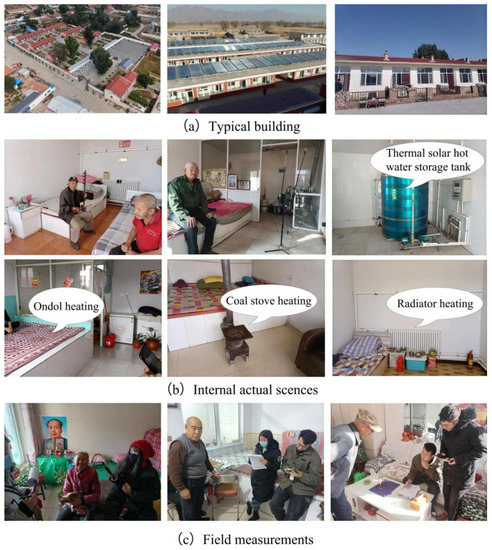
Figure 2.
Typical heating means of mutual aid homes. (a) Typical building; (b) Internal actual scences; (c) Field measurements.
To gain an accurate insight into the current state of the indoor thermal environment of existing mutual aid homes, the field test of the present study was, aside from the subjective questionnaires, divided into two parts, including long-term, fixed-point testing and actual, on-site thermal environment measurements. The measured indicators during the test included indoor air temperature, outdoor air temperature, relative humidity, black bulb temperature, and air flow rate. The measurement range and accuracy of the test instruments met the requirements of ISO7726 and GB/T 50785-2012 standards [30,31]. Parameters of the test instruments are shown in Table 3.

Table 3.
Parameters of the test instruments.
A typical mutual aid elderly building using coal stove and kang heating was selected for long-term, fixed-point tests, and on-site measurements were conducted from 21 December 2020 to 24 December 2020. Four measuring points were arranged in the main rooms: the living room, bedroom, kitchen, and bathroom. The measuring points were installed at a height of 1.5 m, and the sampling frequency was set to 1 min. The location of the measuring point is shown in Figure 3.
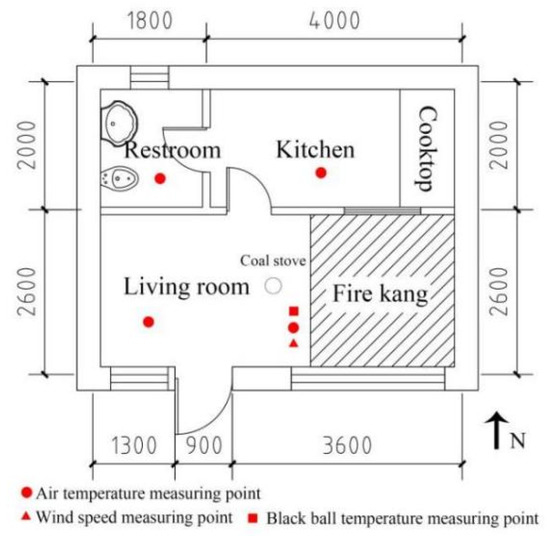
Figure 3.
The layout of the building and locations of measuring points.
Indicators of the thermal environment during the subjective questionnaire were measured at heights of 0.6 m (sitting and sleeping) and 1.1 m (standing) from the ground. All points were within 1 m from the respondent to prevent interference from heat sources.
2.4. Thermal Comfort Evaluation Indicators
Currently, the thermal comfort evaluation index of the built environment can be roughly divided into two models, including the “steady-state model” and “adaptive model”. In this regard, the predicted mean vote (PMV) model is the most widely used steady-state model [32], which has been adopted by international standards, such as ASHRAE Standard 55 and ISO Standard 7730, to evaluate human thermal comfort in buildings with a constant temperature and air conditioning equipment. On the other hand, the “adaptive model” proposed by deDear and Brager is mainly used in unheated or uncooled, naturally ventilated buildings [33]. It should be noted that many thermal comfort evaluation indices for different types of buildings have been proposed to study thermal comfort. Accordingly, choosing the appropriate evaluation index is of significant importance when looking to improve evaluation accuracy [32].
In thermal comfort studies, thermal sensation vote (TSV) is defined as the thermal sensation vote value at a certain temperature, and mean thermal sensation (MTS) refers to the mean value of the thermal sensation vote, which is combined with the temperature-frequency method (bin method) to determine temperature intervals and find the total thermal sensation vote value in these intervals. Comparison of TSV with MTS indicates that TSV has a certain degree of chance, which leads to large deviations of linear fit for data of small volume, while MTS can reasonably avoid the error caused by the occurrence of chance [34]. In the present study, three thermal comfort evaluation models, including PMV, TSV, and MTS, were used to analyze the thermal comfort of the elderly in central Inner Mongolia and find the most accurate model.
Wang Zhaojun et al. [34] studied the thermal comfort of farmhouses in the severely cold region of northern China and found that the indoor air temperature and the average radiation temperature had a large difference in the heating season, and the thermal radiation had a greater impact on human comfort. Considering the convective and radiation heat exchange between people and the environment, the operating temperature was used as an accurate thermal comfort evaluation index. It is worth noting that, in many aspects, the rural mutual aid homes in central Inner Mongolia are similar to the farm buildings in the cold regions. For example, both buildings use the decentralized heating method of coal stove and kang. Accordingly, the operation temperature was selected in the present study as the thermal comfort evaluation index.
According to the ISO7730-2005 standard, when the average air velocity is less than 0.1 m/s, the operating temperature top can be approximated by the average of the mean radiant temperature tmr and air temperature ta [35] using the following expression:
where ta is the air temperature, °C, tg is the black sphere temperature, °C, and v is the indoor air velocity, m/s.
top = 0.5ta + 0.5tmr
tmr = tg + 2.44v1/2(tg − ta)
tmr = tg + 2.44v1/2(tg − ta)
3. Analysis of Results
3.1. Analysis of Indoor Thermal Environment
Table 4 shows that the average temperature in the kitchen and bedroom was 19.5 and 18.5 °C, respectively, which was relatively high compared to the temperature of the other spaces in the studied mutual aid homes. This is because the elderly people in the area often eat, sleep, and spend time on the fire kang. Moreover, the fire kang near the coal stove is the most frequently active area indoors. The bedroom is heated by the coal stove, and the kitchen stove is connected to the kang for cooking activities and to heat the kang, thereby increasing the temperature in both rooms. The living room and the toilet are unheated rooms; therefore, they have lower temperatures.

Table 4.
Values of indoor environmental parameters.
Figure 4a reveals that there was a significant diurnal indoor temperature difference. It was observed that the temperature of the kitchen and bedroom rises at 8:00, 12:00, and 18:00 each day, which mainly originates from cooking activities and room heating. Then, the coal stove is turned off to save heating costs, which leads to large fluctuations in the room temperature. The average temperature of the living room temperature at the measurement point was 9.1 °C. This low temperature may be attributed to the distance from the fireplace and coal stove. The average indoor humidity varied between 30% and 60%, which meets the requirements of the elderly in a residential building.
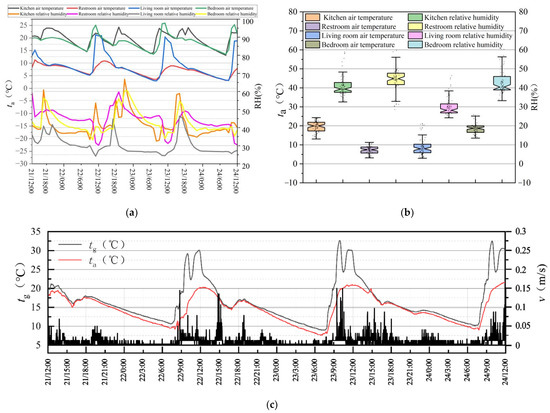
Figure 4.
Analysis of the indoor thermal environment. (a) Indoor temperature and humidity variation during the day from 21 December to 24 December; (b) Chamber line diagram of indoor temperature and humidity; (c) Distribution of indoor black bulb temperature against the wind speed.
Figure 4c shows that, during the middle of the day, the high black bulb temperature was significantly higher than the air temperature, and the air temperature in the south-facing bedroom and living room reached 20 °C. This is because of solar radiation. The average indoor wind speed was 0.03 m/s, indicating that the indoor air can be assumed stationary.
The site environmental parameters collected from the questionnaire were compiled, and the obtained results, including the data for indoor and outdoor temperature, relative air humidity, black bulb temperature, mean radiant temperature, operating temperature, and indoor air velocity are presented in Figure 5. It was found that the indoor air temperature ranged from 13.5 to 22.7 °C with an average temperature of 19.1 °C, and the relative humidity ranged from 24.5 to 56.1% with an average relative humidity of 36.3%. These results are consistent with the actual thermal environment measurements.
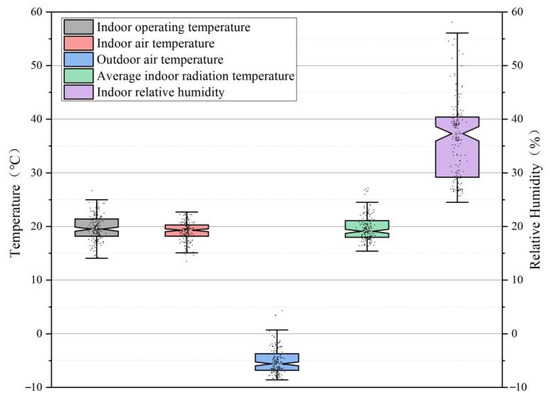
Figure 5.
Chamber line diagram of questionnaire test data.
3.2. Thermal Adaption: Behavioral and Psychological Adjustments
Studies showed that the metabolic rate is closely related to the activity level. The activity level of the interviewed elderly was generally dominated by sedentary activities, sleeping, and housework indoors. According to ISO7730 [35], the mean metabolic rate of an elderly person in this area is 1.18 met. However, the metabolic rate in ISO7730 is calculated based on the body mass index of young healthy adults, so it cannot be used for the elderly [36]. The metabolic rate of the human body decreases with age [37]. Accordingly, the metabolic rate can be approximated by reducing the standard value by 0.1 for elderly people, which is more consistent with the actual metabolic rate. The final mean metabolic rate for the surveyed elderly was 1.08 clo.
Generally, there are four methods to regulate indoor thermal comfort in winter: closing windows and doors, increasing and decreasing clothing, performing light indoor activities, and turning on heating equipment. In order to prevent cold air from entering the room, the elderly living in the mutual aid building usually open the windows for a short time in winter. They often choose to open windows for ventilation at noon when the solar radiation is high or when they are out. Meanwhile, due to their age, they rarely engage in light activities indoors. The predominant method of regulating thermal comfort in winter is turning on heating equipment and increasing and decreasing clothing.
According to the questionnaire results, the average clothing thermal resistance of 187 respondents was 1.36 clo. It was found that the elderly do not reduce their clothing in time even when the thermal sensory poll was slightly warm or warm (TSV = +1, and +2). However, they wear heavy clothing, such as cotton jackets and vests, in a cold environment. Figure 6 shows that the thermal resistance of clothing increases with age. The average thermal resistance of clothing for the elderly in the age range of 60–69, 70–79, and 80 years and older is 1.27 clo, 1.34 clo, and 1.41 clo, respectively. Figure 7 shows the results of fitting the thermal resistance of clothing with indoor operating temperature. It was observed that, as the indoor operating temperature increases, the thermal resistance of the clothing of the elderly gradually decreases. The greater the age, the lower the slope of the fitted line, indicating that the thermal sensitivity also decreases with age.
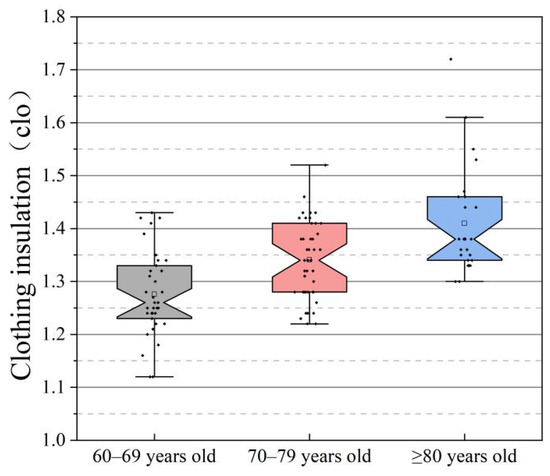
Figure 6.
Distribution of thermal resistance of garments for elderly of different ages.
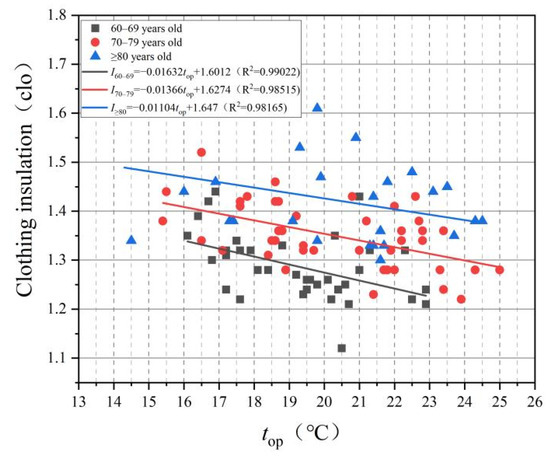
Figure 7.
Distribution of thermal resistance of garments at different room temperatures.
As the existing mutual aid homes in central Inner Mongolia are mainly heated by coal stoves and kang bed-stoves, the elderly turn the coal stoves on and off according to the indoor and outdoor temperatures, their living habits, and financial ability. According to the performed survey, about 1–3 tons of coal is consumed annually per household for winter heating, costing around RMB 1500–4500 annually, which is about 20–30% of the total annual costs of the elderly in the region. In order to reduce heating costs, the elderly usually do not use the coal stove for a long time but turn it on and off according to their thermal comfort. Generally, the elderly endure the cold for a while before turning on the coal stove. Moreover, when burning coal in the stove, smoke may enter the room. Accordingly, the elderly usually turn off the coal stove at night to prevent the risk of gas poisoning. Between 12:00 noon and 3:00 p.m., cooking activities and solar radiation affect the indoor air temperature, thereby heating the indoor room. Subsequently, the elderly usually turn the coal stove off. In the morning, around 7:00 a.m., when the indoor space is relatively cold, the coal stove is turned on to regulate the indoor air temperature and heat the fire bed to ensure comfort during sleep.
Figure 8 shows the correlation between outdoor air temperature and indoor operating temperature. It is observed that for outdoor air temperatures of −7–−3 °C, the indoor operating temperature is high. Moreover, it is observed that the indoor temperature significantly decreases when the outdoor temperature is in the range of −3–0.5 °C. At outdoor temperatures above zero, the indoor temperature increases with higher outdoor temperatures. The comparison of the fitted curves for the three age groups of seniors indicates that the slope of the fitted results for the elderly over 80 years approaches zero, demonstrating that elderly over 80 years old are less sensitive to outdoor temperature changes. This phenomenon may also be attributed to the higher thermal resistance of clothing.
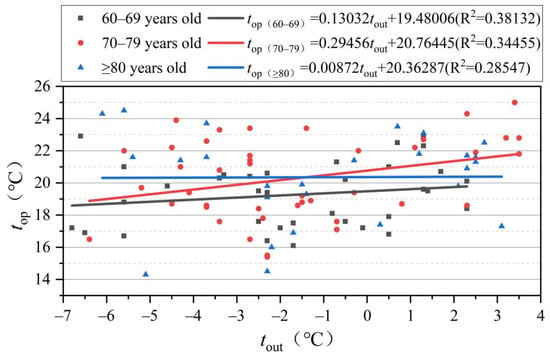
Figure 8.
Distribution of indoor operative temperature against the outdoor air temperature.
3.3. Thermal Sensation and Acceptable Temperature Range
According to the operating temperature (top), the fitted equations can be expressed as follows:
PMV = 0.25407top − 5.19548 (R2 = 0.98603)
TSV = 0.20446top − 4.15068 (R2 = 0.98606)
MTS = 0.16863top − 3.46059 (R2 = 0.98558)
TSV = 0.20446top − 4.15068 (R2 = 0.98606)
MTS = 0.16863top − 3.46059 (R2 = 0.98558)
It is worth noting that the actual thermal sensory voting value (TSV) was derived from the results of the questionnaire. Moreover, the MTS was obtained by combining the temperature frequency method to find the average value of TSV for each temperature interval as MTS. The PMV was obtained by substituting the affecting parameters, such as thermal resistance of clothing, metabolic rate, air temperature, relative humidity, radiant temperature, and room air velocity, into the PMV model.
When MTS, TSV, and PMV are set to zero, the room space can be assumed thermoneutral. It was found that the thermal neutral temperatures of MTS, TSV, and PMV are 20.52 °C, 20.3 °C, and 20.45 °C, respectively. However, Figure 9 reveals that there is a significant “scissor difference” between the PMV fitting results and the other two groups. Although the gradients in a thermoneutral temperature are intrinsically small, the PMV method does not accurately predict the thermal sensation of the elderly at cold and hot room temperatures. Comparison of MTS and TSV methods reveals that there exists a “scissor difference” phenomenon, indicating that TSV may be affected by the number of data samples, resulting in a lower correlation between TSV and the linear fit of the room operating temperature (top). On the other hand, MTS can reasonably avoid these errors, resulting in a higher correlation between MTS and the curve fitting results. This is more consistent with the actual situation. When MTS = 0, the thermoneutral operating temperature for the elderly in the area is 20.52 °C.
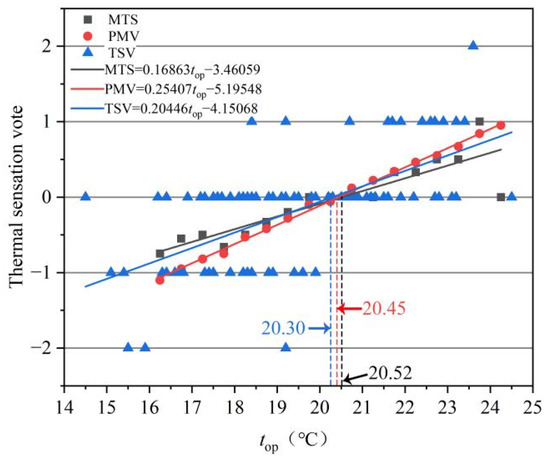
Figure 9.
Distribution of the TSV against the operative temperature.
As only four of the 187 validly scored questionnaires had heat sensation votes of −3, −2, +2, and +3, it was not possible to calculate the acceptable temperature range using a quadratic regression fit between the actual dissatisfaction rate and the operational temperature. Accordingly, the acceptable temperature range of the elderly in the area was calculated based on the MTS fitting equation. When −0.5 ≤ MTS ≤ 0.5, the 90% comfortable temperature range is 17.55–23.49°C, and when −0.85 ≤ MTS ≤ 0.85, the 80% acceptable temperature range for the elderly is 15.48–25.56°C. It is found that the acceptable temperature range for older people in the area is wide. This method was used to calculate the acceptable temperature range with promising accuracy [37,38,39].
The slope of the fitted line in thermal comfort studies reflects the sensitivity of the respondents to the temperature [40,41]. Therefore, the interviewed elderly were divided into three groups based on their age: 60–69 years, 70–79 years, and 80 years or older. Then the thermal sensory votes of these three groups were fitted to the room operating temperature. Figure 10 shows that the thermal sensitivity of the elderly gradually decreases with age, which is consistent with geriatric physiology studies [42]. This may be attributed to the continuous decrease of the efficiency of cold and warmth defense mechanisms and sensing and responding to temperature changes with age. On the other hand, this phenomenon may originate from adaptive thermal comfort behaviors. The comparison of the thermal resistance of clothing for the elderly of different ages indicates that the elderly over 80 have the highest thermal resistance to clothing, so they add and remove clothing less frequently and wear heavy clothing for long periods of time. Accordingly, they rarely feel cold when the indoor temperature drops.
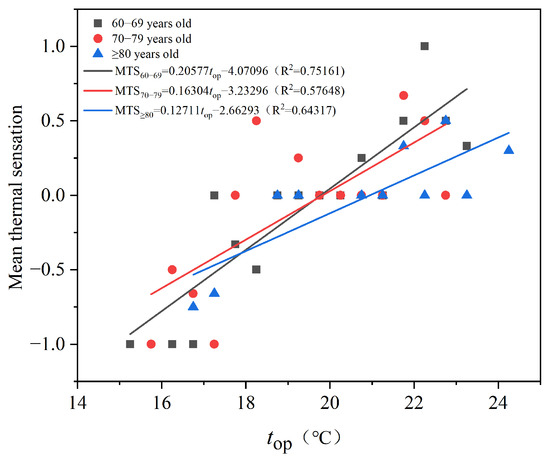
Figure 10.
Distribution of MTS against the operating temperature for the elderly of different ages.
3.4. Thermal Expectations
The thermal expectation temperature reflects the expected value at deviations of neutral indoor temperature from the ambient temperature. The subjective thermal expectation poll can be divided into three classes, −1, 0, and 1, representing the favoring of cooler, constant, and hotter temperatures, respectively. The percentages of the two poll values of −1 and 1 at different operating temperatures were calculated in conjunction with the bin method [34]. In this regard, Figure 11 presents the fitted curves.

Figure 11.
Distribution of thermal expected temperatures.
The “hope warmer” and “hope cooler”, called W and C, respectively, can be expressed as follows:
W = −18.8909top + 408.9318 (R2 = 0.97534)
C = 16.6703top − 341.2280 (R2 = 0.96102)
C = 16.6703top − 341.2280 (R2 = 0.96102)
The thermal expectation temperature for the elderly in the area is 21.09 °C. Figure 11 reveals that, when the indoor operating temperature is in the range of 19 to 23 °C, more than 60% of the elderly are satisfied with the temperature, indicating that the elderly of the studied area do not have high expectations for the indoor temperature. When the indoor temperature is cold, the elderly generally want to be warmer. On the other hand, when the indoor temperature is high, the number of votes expected to be cooler is significantly less than the votes of the other two conditions, indicating that the elderly of the studied area prefer a warm environment. Because of the fear of falling ill and catching a cold due to reducing clothing, the elderly reluctantly reduce clothing even in warmer environments and consider hotter environments more comfortable.
3.5. Indoor Comfort
Thermal comfort refers to an environment that is neither hot nor cold. This indicator is widely used to describe the satisfaction degree of residents with the thermal condition of the building. In the present study, the thermal comfort of elderly people in rural mutual care buildings in central Inner Mongolia was studied using the thermal comfort voting (TCV) evaluation method. To this end, the intuitive feelings of the elderly about the degree of thermal comfort were classified into five different levels. The voting results are presented in Figure 12.
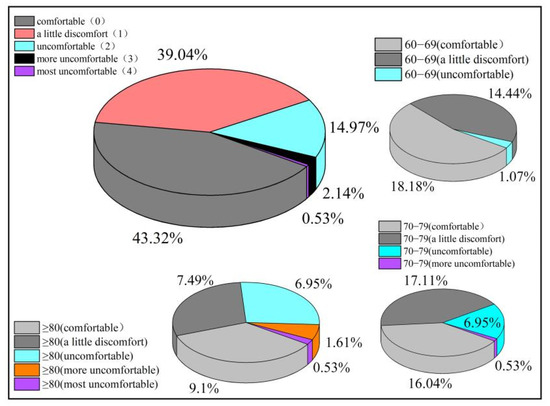
Figure 12.
Indoor thermal comfort statistics chart.
The performed analysis indicates that 43.32% of the elderly are in thermal comfort, while 39.04% feel somewhat uncomfortable, 14.97% considered it uncomfortable, and 2.14% considered it very uncomfortable, and only one elderly considered it most uncomfortable. The low dissatisfaction rate may be because all the interviewed elderly are permanent residents of the area and have fully adapted to the climate and indoor thermal environment of the region.
According to the thermal comfort voting results, 56.68% of the elderly have different degrees of uncomfortable feelings, and there was no vote higher than 3 among the elderly under 70. Furthermore, the percentage of the elderly over 70 who voted for different degrees of uncomfortable was about two-thirds of the total votes in this age group, indicating that, for older elderly, the existing mutual aid elderly buildings do not meet their physiological needs. It is inferred that the level of the indoor thermal environment should be improved at least for this age group.
The evaluation results of indoor wet and wind sensation revealed that the interviewed elderly are fully adapted to humid and windy conditions indoors. More specifically, more than 80% of the elderly prefer indoor windless environment in winter, and some of the interviewed people think that the low indoor wind speed is mainly due to the uncomfortable feeling of poor indoor air quality originating from windows that are always closed in winter. Respondents believe that the high wind speed in the interior space mainly originates from poor airtightness of the doors and windows, which results in air leakage. Indoor wet feeling also has a high sense of comfort. More specifically, more than 95% of the elderly believe that the indoor humidity is appropriate. However, according to the results of the thermal environment test, the indoor relative humidity varies in the range of 30–40% most of the time, indicating that the indoor air is relatively dry. Therefore, the room should be humidified.
3.6. Adaptive Thermal Comfort Model
The adaptive thermal comfort model is based on different climates and research objects to describe the correlation between indoor thermal neutral temperature and outdoor temperature. Studies showed that this model can be effectively applied to predict the corresponding indoor thermal neutral temperature for different outdoor temperatures [43,44]. The indoor thermoneutral temperature tn and the average outdoor temperature tout were regressed to obtain the thermal adaptation model. The obtained results are presented in Figure 13.
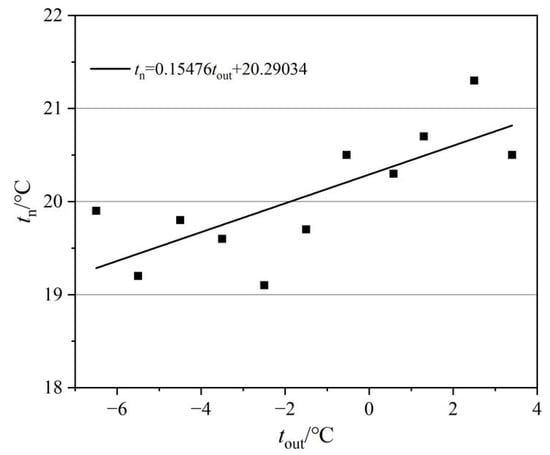
Figure 13.
Distribution of outdoor and thermal neutral temperatures.
The thermal adaptation model can be expressed as follows:
tn = 0.15476tout + 20.29034 (R2 = 0.8769)
It indicates that the indoor thermal neutral temperature increases with the outdoor air temperature. When the outdoor temperature rises by 6.46 °C, the thermal neutral temperature of the elderly rises by 1 °C, indicating that the rural elderly are relatively insensitive to the variations of the outdoor temperature. Moreover, it indicates that the indoor thermal comfort is not absolute but is affected by the variations in the outdoor thermal environment, and the human body adjusts its functions to adapt to variations of the outdoor environment. It is inferred that this theory is also applicable to the elderly in retirement buildings under non-steady-state conditions. Therefore, the indoor thermal comfort of elderly buildings should be viewed dynamically by combining the outdoor temperature and the adaptive function of the human body.
4. Discussion
4.1. Comparison with Previous Research Results
Table 5 shows the thermal comfort of the elderly in winter in different regions of China. It is observed that the thermal neutral temperature of the elderly in rural areas in central Inner Mongolia is higher and not much different from that of the elderly in urban areas that have heating conditions. Compared with the acceptable temperature range of the elderly in urban central heating conditions, the acceptable temperature range for the elderly in rural areas is around 10 °C. This wide range may be attributed to the lack of central heating in rural retirement buildings, which results in remarkable variations in the indoor temperature. Compared with the elderly who live in a constant-temperature environment for a long time, the rural elderly are subjected to more hot and cold stimuli, thereby requiring them to make psychological and behavioral adjustments according to their thermal sensory state [45]. The performed analysis demonstrated that people should not stay in a thermoneutral environment without hot and cold stimulation for long periods of time, and appropriate hot and cold stimulation is of great benefit in maintaining the body’s heat stress capacity, preventing obesity, and preventing some diseases. Moreover, further investigations [11,46] confirmed that hot summers and cold winters negatively affect the health of the elderly and increase heat-related morbidity and mortality. Accordingly, although there is a wide range of acceptable temperatures for the elderly, the indoor temperature of mutual aid homes should fluctuate within a safe range that does not negatively affect the health of the elderly.

Table 5.
Comparison of thermoneutral temperatures in different regions.
4.2. Adaptive Thermal Comfort
Results from naturally ventilated buildings in practice revealed that satisfaction with the thermal environment does not mean that this environment has to be controlled at a constant indoor air temperature [33]. These findings led to the adaptive thermal comfort approach and caused a significant paradigm shift away from the heat-balance-based approach [50]. The adaptive approach accounts for the fact that humans adapt to seasonal variations in environmental conditions. Application of the adaptive thermal comfort approach, therefore, results in a more varied indoor thermal climate, depending on the outdoor conditions [33].
In addition to energy-saving potential, a recent study search indicated that the adaptive temperature approach can have significant health effects [51]. While, conventionally, thermal comfort and health are considered as synonyms and, therefore, the tightly controlled PMV approach is regarded as most healthy, recent findings suggest that it might be healthier to expose people to temperatures outside the thermoneutral zone [51].
In the central region of Inner Mongolia, there are no unified heating facilities, and the elderly people adjust the indoor temperature independently according to their heat sensation and economic status. According to the performed survey, the elderly of this area do not adjust the indoor temperature immediately even when it is lower than 15 °C. Instead, they endure it for a while or add more clothes. Therefore, the indoor temperature varies widely between the heating period and the non-heating period; but, it is interesting that, even in the non-heating period, the thermal sensation evaluation of many elderly people is relatively good. This is similar to the findings of Fan et al. Fan et al. investigated the thermal environment of the elderly in China living in rural and urban areas in heating season and found that, despite the lower air temperatures in rural houses, the elderly reported that the indoor thermal environment was acceptable [25]. This may be the result of adaptive thermal comfort behavior.
4.3. Application
Considering the problem of China’s aging rural population, the demand for rural mutual aid homes will increase in the near future. Unlike other well-equipped elderly care facilities, rural mutual aid homes do not charge the elderly any care fees and are exempted from utility bills. However, these elderly people have to pay their heating costs in winter. Since the main target community of mutual aid homes are rural poor and widowed elderly, economic conditions have become a key factor limiting the indoor thermal environment of mutual aid retirement buildings, thereby affecting the thermal comfort of the elderly. Studies showed that, if this scheme means spending more money, low-income seniors usually give up the need to renovate their houses to improve comfort [52]. However, the construction of mutual aid homes is mostly funded by the government. Therefore, it is recommended that the government increase investment in mutual aid buildings for the elderly and build more livable residential houses for the elderly. More frequent use of heating equipment by the elderly in winter leads to more energy consumption, thereby imposing a financial burden and leaving less money available for other issues, such as medical treatment, which may result in health problems [12].
Based on the above problems, the following improvements are suggested:
- (1)
- Improve the thermal insulation and airtightness of the building envelope. The existing building envelope of the rural courtyard has high heat loss, and the roof and external walls have no insulation. Consequently, there is a remarkable heat loss resulting in great energy consumption. It is recommended that an external insulation layer be added, which can reduce heat loss and improve the characteristics of the brick wall. The airtightness of the doors and windows should also be strengthened using additional door curtains and double-paned windows with an air interlayer;
- (2)
- Make full use of solar energy through a combination of active and passive means. It is recommended that a sunroom be added on the south side of the building to passively utilize solar energy and store excess solar heat during the day and release it at night to improve the large temperature difference between day and night indoors. The sunroom can also serve as a buffer space to prevent cold winds from penetrating directly into the interior through the entry door and windows in winter. It is also recommended that the heating method of the existing fire kang and coal stove be changed, solar heating equipment be adopted, and a temperature control device be installed, which can not only reduce the heating consumption of the elderly in winter but also reduce the use of non-renewable energy;
- (3)
- Plan the building’s form factor and window-to-wall ratio. To ensure the building’s body shape factor, the area of the south elevation should be increased to receive more solar radiation. The window–wall ratio of each orientation should be reasonably controlled; east–west window openings should preferably not be used, the area of the north-facing windows should be reduced to prevent cold wind penetration, and the area of south-facing exterior windows should be increased to receive more solar radiation. The impact of the local winter monsoon on the building should also be considered, and the location of doors and windows should be on the leeward side or have additional door buckets;
- (4)
- Plant greenery reasonably. In order to reduce the adverse health impacts of the low humidity originating from burning coal stoves, the transpiration effect of greenery can be used to improve indoor humidity conditions;
- (5)
- Give the elderly a corresponding heating subsidy or establish central heating facilities. Since heating costs are high in winter, the elderly can be given appropriate heating subsidies. The heat-neutral temperature of the elderly over 80 is significantly higher than that of the younger elderly. It is proposed that the elderly of different ages receive appropriate heating subsidies for the differences in their thermal comfort. Another solution is that the government and the village committee can fund the improvement and upgrading of the heating facilities of mutual aid homes.
5. Conclusions
In the present study, the rural mutual elderly buildings in the central region of Inner Mongolia were considered as the research object. A thermal comfort model was established for the rural elderly in winter by measuring the indoor thermal environment of the existing facilities in the region and investigating indoor thermal comfort. Based on the obtained results, the main achievements of the present study can be summarized as the following:
- (1)
- The adaptive behavior of the elderly to the indoor thermal environment is mainly limited to increasing and decreasing clothing, and the average clothing thermal resistance is 1.36 clo. As the elderly age, the clothing thermal resistance gradually increases. This is because the elderly are concerned that reducing clothing may increase the probability of illness;
- (2)
- The actual thermal neutral temperature of rural elderly is 20.52 °C. Moreover, the acceptable temperature for 80% and 90% acceptable temperatures are 15.48–25.56 °C and 17.55–23.49 °C, respectively, which is significantly lower than the winter comfort temperature range recommended by the ASHRAE 55-2017 standard (21.0–24.0 °C). It was found that the thermal neutral temperature and acceptable temperature range of the elderly of different ages vary significantly. More specifically, the acceptable range for the elderly of 60–69, 70–79, and 80+ years is 19.78 °C, 19.82 °C, and 20.94 °C, respectively. The thermal sensitivity of the elderly decreases with age;
- (3)
- The thermal expectation temperature of the elderly is 21.09 °C, which is 0.57 °C higher than the thermoneutral temperature, indicating that the elderly of the area are more accepting of partially hot environments and have higher psychological expectations of hot environments. According to the adaptive thermal comfort model, it is found that, when the outdoor temperature rises by 6.46 °C, the thermal neutral temperature of the elderly rises by 1 °C, indicating that the rural elderly in this area are less sensitive to outdoor temperature changes;
- (4)
- The subjective evaluation of the existing rural mutual aid homes’ indoor thermal comfort by the elderly revealed that 43.32% of the voters feel comfortable, while 56.68% of the elderly have different degrees of discomfort. The former proportion decreases with age, indicating that the existing rural facilities are not able to meet the thermal comfort needs of the majority of the elderly. Accordingly, the indoor thermal environment should be improved urgently.
The limitations of this study are the small size of the existing mutual aid homes in the area and the small number of elderly residents, which leads to a small volume of data. Moreover, room heating using coal stove and kang can cause excessive smoke and high CO2 concentration in the room, which may threaten the physiological health of the elderly. In the near future, further investigations will be carried out on the comfort of the elderly and indoor CO2 concentration using wearable physiological monitoring devices.
Author Contributions
This paper is the result of free, full, and equal collaboration among all authors. H.L. is responsible for the questionnaire survey, field measurements, data compilation, and the writing of the first draft of the paper. G.X. and J.C. conceived the paper and validated the methods, data, and conclusions. J.D. was involved in the preliminary research, questionnaire survey, and data compilation. All authors have read and agreed to the published version of the manuscript.
Funding
This research was funded by the National Natural Science Foundation of China (grant no. 52168006), the significant science and technology subject of Inner Mongolia “The green building system integration optimization and engineering demonstration of grassland based on the cultural inheritance”.
Institutional Review Board Statement
The study was conducted in accordance with the Declaration of Helsinki, and approved by the Institutional Review Board (or Ethics Committee) of Inner Mongolia University of Technology (protocol code 2020000005 and date of approval on 9 January 2020) for studies involving humans.
Informed Consent Statement
Informed consent was obtained from all subjects involved in the study. Written informed consent has been obtained from the patients to publish this paper.
Data Availability Statement
Not applicable.
Conflicts of Interest
The author declares no conflict of interest.
References
- Yu, C.; Lee, Y. Housing requirements for a ageing society. Indoor Built Environ. 2017, 26, 441–446. [Google Scholar] [CrossRef]
- World Health Organization. World Population Ageing, Department of Economic and Social Affairs, Population Division, U.N.; World Health Organization: Geneva, Switzerland, 2015. [Google Scholar]
- Xu, T.; Zhang, Y. Thoughts and measures to cope with rural population aging positively during the 14th five-year plan period. Reform 2021, 10, 31–40. [Google Scholar]
- Li, D.; Bi, H. A review of study on mutual-aid elderly care in China. Sci. Res. Aging 2020, 8, 44–53. [Google Scholar]
- Zhang, C.; Xiong, C. The development and enlightenment of the model of mutual aid villages in rural communities in the United States. Probe 2015, 6, 132–137, 149. [Google Scholar]
- He, Q. Reference and enlightenment of foreign mutual aid models for the elderly in rural areas of China. Agric. Econ. 2018, 6, 74–75. [Google Scholar]
- Miller, J. Daring to take on female roles: Japanese male retirees as volunteer carers. Japanstudien 2010, 21, 253–270. [Google Scholar] [CrossRef]
- Mulliner, E.; Riley, M.; Maliene, V. Older People’s Preferences for Housing and Environment Characteristics. Sustainability 2020, 12, 5723. [Google Scholar] [CrossRef]
- World Health Organization. Chapter 2 Healthy Ageing, World Report on Ageing and Health; World Health Organization: Geneva, Switzerland, 2015. [Google Scholar]
- O’Neill, B.; Banoobhai, M.; Smith, C. Teaching Literacy through Dramatic Storytelling in Foundation Phase. Australas. J. Early Child. 2016, 41, 95–102. [Google Scholar] [CrossRef]
- Van Hoof, J.; Schellen, L.; Soebarto, V. Ten questions concerning thermal comfort and ageing. Build. Environ. 2017, 120, 123–133. [Google Scholar] [CrossRef]
- Soebarto, V.; Zhang, H.; Schiavon, S. A thermal comfort environmental chamber study of older and younger people. Build. Environ. 2019, 155, 1–14. [Google Scholar] [CrossRef]
- Mao, Y. Study on Climate Adaptive of Human Beings to Thermal in China. Master’s Thesis, Xi’an University of Architecture and Technology, Xi’an, China, 2006. [Google Scholar]
- Van Hoof, J.; Hensen, J. Thermal comfort and older adults. Gerontechnology 2006, 4, 223–228. [Google Scholar]
- Giamalaki, M.; Kolokotsa, D. Understanding the thermal experience of elderly people in their residences: Study on thermal comfort and adaptive behaviors of senior citizens in Crete, Greece. Energy Build. 2019, 185, 76–87. [Google Scholar] [CrossRef]
- Howden-Chapman, P. Housing standards: A glossary of housing and health. J. Epidemiol. Community Health 2004, 58, 162–168. [Google Scholar] [CrossRef]
- Ebersole, P.; Hess, P.; Luggen, A.S. (Eds.) Toward Healthy Aging, 6th ed.; Mosby: St. Louis, MO, USA, 2004. [Google Scholar]
- Natsume, K.; Ogawa, T.; Sugenoya, J.; Ohnishi, N.; Imai, K. Preferred ambient temperature for old and young men in summer and winter. Int. J. Biometeorol. 1992, 36, 1–4. [Google Scholar] [CrossRef] [PubMed]
- Lee, J.S.; Song, M.K.; Kim, H.E. Physiological responses and subjective sensations by age through seasonal condition. Fash. Text. Res. J. 2009, 11, 833–839. [Google Scholar]
- Tartarini, F.; Cooper, P.; Fleming, R. Thermal environment and thermal sensations of occupants of nursing homes: A field study. Procedia Eng. 2017, 180, 373–382. [Google Scholar] [CrossRef]
- Panraluk, C.; Sreshthaputra, A. Thermal comfort of the elderly in public health service buildings of thailand. Appl. Mech. Mater. 2018, 878, 173–178. [Google Scholar] [CrossRef]
- Panraluk, C.; Sreshthaputra, A. Developing Guidelines for Thermal Comfort and Energy Saving during Hot Season of Multipurpose Senior Centers in Thailand. Sustainability 2020, 12, 170. [Google Scholar] [CrossRef]
- Yao, X. Investigation and analysis of indoor thermal environment in welfare centers for the aged in Shanghai. Heat. Vent. Air Cond. 2011, 41, 66–70. [Google Scholar]
- Liu, H.; Wu, Y.; Zhang, H.; Du, X. Field study on elderly people’s adaptive thermal comfort evaluation in naturally ventilated residential buildings in summer. Heat. Vent. Air Cond. 2015, 45, 50–58. [Google Scholar]
- Fan, G.; Xie, J.; Yoshino, H.; Yanagi, U.; Hasegawa, K.; Wang, C.; Zhang, X.; Liu, J. Investigation of indoor thermal environment in the homes with elderly people during heating season in Beijing, China. Build. Environ. 2017, 126, 288–303. [Google Scholar] [CrossRef]
- Zheng, W.; Shao, T.; Che, D.; Liu, Y.; Zhou, F. Adaptive thermal comfort of the elderly in Xi’an, China. Heat. Vent. Air Cond. 2021. Available online: http://kns.cnki.net/kcms/detail/11.2832.tu.20211026.2117.002.html (accessed on 20 May 2022).
- Jin, H.; Zhao, H.; Wang, X. Research on the indoor thermal comfort environment of rural housing in winter in super-cold region. J. Harbin Inst. Technol. 2006, 12, 2108–2111. [Google Scholar]
- Kottek, M.; Grieser, J.; Beck, C.; Rudolf, B.; Rubel, F. World map of the Köppen-Geiger climate classification updated. Meteorol. Z. 2006, 15, 259–263. [Google Scholar] [CrossRef]
- Corgnati, S.P.; Ansaldi, R.; Filippi, M. Thermal comfort in Italian classrooms under free running conditions during mid seasons: Assessment through objective and subjective approaches. Build. Environ. 2009, 44, 785–792. [Google Scholar] [CrossRef]
- ISO 7726; Thermal Environment-Instruments and Method for Measuring Physical Quantities International Standard Organization. ISO: Geneva, Switzerland, 1998.
- GB/T 50785-2012; Evaluation Standard for Indoor Thermal Environment in Civil Buildings. Ministry of Housing and Urban-Rural Development of the People’s Republic of China. China Architecture & Building Press: Beijing, China, 2012.
- Fanger, P.O. Thermal Comfort Analysis and Applications in Environmental Engineering; Danish Technical Press: Copenhagen, Denmark, 1972. [Google Scholar]
- De Dear, R.J.; Brager, G.S. Developing an adaptive model of thermal comfort and preference. ASHRAE Trans. 1998, 104, 1–18. [Google Scholar]
- Wang, Z. Selection of thermal comfort indexes in the field study. Heat. Vent. Air Cond. 2004, 12, 39–42. [Google Scholar]
- ISO 7730; Ergonomics of the Thermal Environment—Analytical Determination and Interpretation of Thermal Comfort Using Calculation of the PMV and PPD Indices and Local Thermal Comfort. International Standardization Organization: Geneva, Switzerland, 2005.
- Jiao, Y.; Yu, H.; Wang, T.; An, Y.; Yu, Y. Thermal comfort and adaptation of the elderly in free-running environments in Shanghai, China. Build. Environ. 2017, 118, 259–272. [Google Scholar] [CrossRef]
- Piers, L.S.; Soares, M.J.; McCormack, L.M.; O’Dea, K. Is there evidence for an age-related reduction in metabolic rate? J. Appl. Physiol. 1998, 85, 2196–2204. [Google Scholar] [CrossRef]
- Huang, L.; Zhu, Y.; Ouyang, Q.; Cao, B. Indoor thermal comfort in rural houses around Beijing in heating season. Heat. Vent. Air Cond. 2011, 41, 83–85, 115. [Google Scholar]
- Wang, Z.; Sheng, X.; Ren, J.; Ji, Y. Field survey on indoor thermal comfort in rural houses around Harbin in winter. Heat. Vent. Air Cond. 2014, 44, 71–75. [Google Scholar]
- Yao, R.; Li, B.; Liu, J. A theoretical adaptive model of thermal comfort–Adaptive Predicted Mean Vote (aPMV). Build. Environ. 2009, 44, 2089–2096. [Google Scholar] [CrossRef]
- Mustapa, M.S.; Zaki, S.A.; Rijal, H.B.; Hagishima, A.; Ali, M.S.M. Thermal comfort and occupant adaptive behaviour in Japanese university buildings with free running and cooling mode offices during summer. Build. Environ. 2016, 105, 332–342. [Google Scholar] [CrossRef]
- Guergova, S.; Dufour, A. Thermal sensitivity in the elderly: A review. Ageing Res. Rev. 2011, 10, 80–92. [Google Scholar] [CrossRef] [PubMed]
- Michael, H. Field Studies of Thermal Comfort Compared and Applied. J. Inst. Heat. Vent. Eng. 1976, 44, 5–27. [Google Scholar]
- Brager, G.S.; De Dear, R.J. Thermal adaptation in the built environment: A literature review. Energy Build. 1998, 27, 83–96. [Google Scholar] [CrossRef]
- Zhu, Y. How to create a healthy and comfortable indoor thermal environment: Exploration on the relationship between the built environment and human comfort and health. World Archit. 2021, 3, 42–45, 126. [Google Scholar]
- Hansen, A.; Bi, P.; Pisaniello, D.; Nitschke, M.; Tucker, G.; Newbury, J.; Kelsall, L. Heat-health behaviours of older people in two Australian states. Australas. J. Ageing 2015, 34, 19–25. [Google Scholar] [CrossRef]
- Wei, X. Research on Design of Pension Facilities for the Elderly in Cold Areas Based on Thermal Comfort. Master’s Thesis, Harbin Institute of Technology, Harbin, China, 2018. [Google Scholar]
- Liu, X.; Yue, P. Investigation and study on winter indoor thermal environment of reconstructed nursing homes for the elderly in Taiyuan. Heat. Vent. Air Cond. 2019, 49, 120–127. [Google Scholar]
- Li, N.; Fang, X.; Wei, Z.; Shen, X.; Wu, Z. research on thermal environment of residences and thermal comfort sensation of elderly in rural areas of western Hunan in winter. J. Hunan Univ. (Nat. Sci.) 2019, 46, 123–128. [Google Scholar]
- De Dear, R.J.; Akimoto, T.; Arens, E.A.; Brager, G.; Candido, C.; Cheong, K.W.D.; Li, B.; Nishihara, N.; Sekhar, S.C.; Tanabe, S.; et al. Progress in thermal comfort research over the last twenty years. Indoor Air 2013, 23, 442–461. [Google Scholar] [CrossRef] [PubMed]
- Van Marken Lichtenbelt, W.; Kingma, B.; Van Der Lans, A.; Schellen, L. Cold exposure-an approach to increasing energy expenditure in humans. Trends Endocrinol. Metab. 2014, 25, 165–167. [Google Scholar] [CrossRef] [PubMed]
- Grösche, P. Housing, energy cost, and the poor: Counteracting effects in Germany’s housing allowance program. Energy Policy 2010, 38, 93–98. [Google Scholar] [CrossRef][Green Version]
Publisher’s Note: MDPI stays neutral with regard to jurisdictional claims in published maps and institutional affiliations. |
© 2022 by the authors. Licensee MDPI, Basel, Switzerland. This article is an open access article distributed under the terms and conditions of the Creative Commons Attribution (CC BY) license (https://creativecommons.org/licenses/by/4.0/).